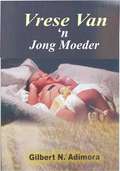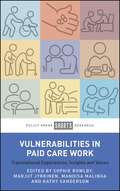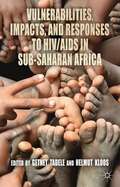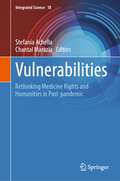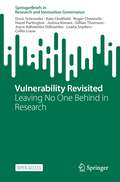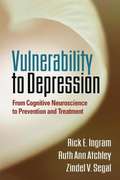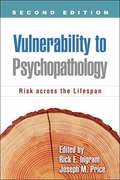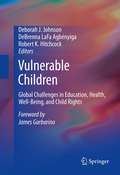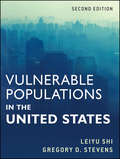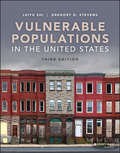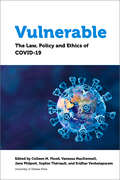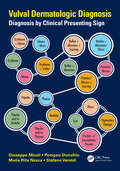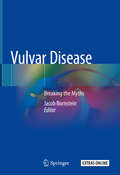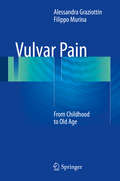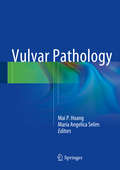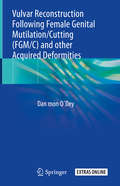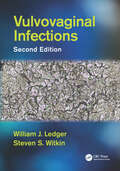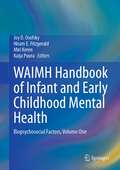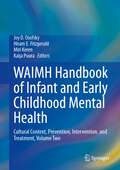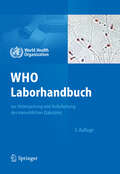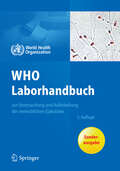- Table View
- List View
Vrese van 'n jong moeder
by Dr Gilbert Adimora Adri De NeckerDie boek is geskryf vir jong ouers, veral die wat nog nie ervare is in die kuns van moederskap om te help om die angs te verlig wat die geboorte en die sorg van ‘n pasgebore baba volg totdat hulle een jaar oud is. Al lyk dit of die titel op moeders fokus, word vaders nie uitgesluit nie en met ook deur hierdie boek gaan omdat hulle ook betrokke is in die bekommernis en begeleidende slapelose nagte. Babas is veronderstel om ‘n gewensde geskenk van God te wees en ‘n bondel vreugte en geluk aan hulle ouers, maar dikwels is hierdie vreugde afgekap deur angs as gevolg van die tekort aan kennis, ‘ou vrou stories’,mites en kulturele gelowe wat dikwels nie baie akkuraat is nie, en stuur dan die jong ouers van plek tot plek in die soeke na oplossings. Snaaks genoeg, meeste bekommernisse is gewonlik ‘n normale proses wat moet gebeur soos wat die nuutgeborene aanpas by die lewe buite die baarmoeder. Party is klein probleempies wat opgelos kan word deur ‘n Pediater of ‘n goeie Huisdokter dikwels deur berading, en bring ‘n gewensde verligting en ‘n ontspanne omgewing in die huis. ‘n Reis na die verkeerde plek of die verkeerde raad van verkeerde mense, kan nie net permanent die kind beskadig nie , maar kan ook lei tot die ondergang van die pasgeborenne of baba met baie rou in die familie. Die feite in hierdie boek is saamgesit om hierdie jong ouers te help om die kennis te kry wat hulle nodig het om hulle pasgebore babas te kan hanteer, om angstigheid te verlig en om goeie gepasde maatreëls toe te pas wat sal help dat die babas ‘n gesonde begin geniet. Dit is ‘n resultaat van baie jare se oefening in kinder gesondheid in beide publieke en private hospital omgewings. Dit sal baie vrae antwoord wat deur jong moeders aan konsultasie pediaters,ander dokters,verpleegsters of ander gesondheids praktisyne gestel word, en soms kwaksalwers oor die sake wat hulle nie nodig het om oor bekommerd te wees nie of uitgesor
Vulnerabilities in Paid Care Work: Transnational Experiences, Insights and Voices
by Sophie Bowlby, Marjut Jyrkinen, Mandisa Malinga and Kathy SandersonThe need for paid care workers to provide professional, good quality care for those needing daily support continues to grow throughout the world. This book explores the recent experiences of diverse paid care workers in four very different national contexts – Finland, Canada, South Africa and England – to learn from their experiences during COVID-19 and its aftermath. Drawing on care workers’ own perspectives, this book shows how recruitment and retention of paid care workers remains challenging due to the pandemic and demographic changes, their precarious labour market position, low pay and the difficulties of delivering care.
Vulnerabilities, Impacts and Responses to HIV/AIDS in Sub-Saharan Africa
by Getnet Tadele Helmut KloosThis book examines HIV/AIDS vulnerabilities, impacts and responses in the socioeconomic and cultural context of Sub-Saharan Africa. With contributions from social scientists and public health experts, the volume identifies gender inequality and poverty as the main causes of the HIV epidemic in sub-Saharan Africa.
Vulnerabilities: Rethinking Medicine Rights and Humanities in Post-pandemic (Integrated Science #18)
by Stefania Achella Chantal MaraziaDrawing from a wide array of disciplinary perspectives and geographical contexts, this volume offers new insights for critically engaging with the problem of vulnerability. The essays here contained take the move from the COVID-19 pandemic, in order to explore the inherent vulnerability of individuals, but also of social, economic and political systems, and probe the descriptive and prescriptive import of the concept.Each chapter provides a self-contained perspective on vulnerability, as well as a specific methodological framework for questioning its meaning. Taken together, the chapters combine into a multi-disciplinary toolkit for approaching the various forms and structures of vulnerability, with a special attention to the intersectional factors shaping the individual experience of it: from gender to age, from disability to mental illness, from hospitalisation to incarceration. The book explores the theoretical richness and complexity of the concept and proposes new analytical approaches to it, before illustrating its multifariousness through empirically grounded case studies. The closing section engages with “the future of vulnerability”, as a hermeneutic, epistemological, and critical-normative perspective to be deployed beyond the domain of global crises and emergencies.The volume is primarily intended as a reference for scholars in the human, social and health sciences. The accessible structure and plain language of the chapters make it also a valuable didactic resource for graduate courses in philosophy, the social sciences and public health.
Vulnerability Revisited: Leaving No One Behind in Research (SpringerBriefs in Research and Innovation Governance)
by Doris Schroeder Roger Chennells Kate Chatfield Hazel Partington Joshua Kimani Gillian Thomson Joyce Adhiambo Odhiambo Leana Snyders Collin LouwOpen access. This open-access book discusses vulnerability and the protection-inclusion dilemma of including those who suffer from serious poverty, severe stigma, and structural violence in research. Co-written with representatives from indigenous peoples in South Africa and sex workers in Nairobi, the authors come down firmly on the side of inclusion. In the spirit of leaving no one behind in research, the team experimented with data collection methods that prioritize research participant needs over researcher needs. This involved foregoing the collection of personal data and community researchers being involved in all stages of the research. In the process, the term ‘vulnerability’ was illuminated across significant language barriers as it was defined by indigenous peoples and sex workers themselves. The book describes a potential alternative to exclusion from research that moves away from traditional research methods. By ensuring that the research is led by vulnerable groups for vulnerable groups, it offers an approach that fosters trust and collaboration with benefits for the community researchers, the wider community as well as research academics. Those living in low-income settings, in dire situations that are summarized with the term ‘vulnerability’ know best what their problems are and which priorities they have. To exclude them from research for their own protection is a patronizing approach which insinuates that researchers and research ethics committees know best. The team from this book have shown that minimally risky and minimally burdensome research tailored towards the needs of highly marginalized and stigmatized communities can be scientifically valuable as well as inclusive and equitable. I congratulate them. Prof. Klaus Leisinger, President Global Values Alliance, Former personal advisor to Kofi Annan on corporate responsibility
Vulnerability to Depression
by Rick Ingram Ruth Ann AtchleyProviding a cutting-edge examination of the mechanisms underlying depression, this volume integrates important areas of research that have largely remained separate. The authors explore both the cognitive and neurological processes that make some people more vulnerable than others to developing depression and experiencing recurrent episodes. They also probe how these processes interact-how negative life experiences, maladaptive belief systems, and patterns of thinking may actually affect neural circuitry, and vice versa. Explaining sophisticated theory and research in an accessible style, the book highlights the implications for improving clinical practices and patient outcomes.
Vulnerability to Psychopathology, Second Edition: Risk across the Lifespan
by Joseph Price Rick IngramThis state-of-the-art work has been highly praised for bridging the divide between adult and developmental psychopathology. The volume illuminates the interplay of biological, cognitive, affective, and social-environmental factors that place individuals at risk for psychological disturbance throughout development. Childhood-onset and adult forms of major disorders are examined in paired chapters by prominent clinical researchers. An integrative third chapter on each disorder then summarizes what is known about continuity and change in vulnerability across the lifespan. Implications for assessment, treatment, and prevention are also considered.
Vulnerable Children
by Deborah J. Johnson Robert K. Hitchcock Debrenna Lafa AgbényigaThey are laborers, soldiers, refugees, and orphans. In areas of the world torn by poverty, disease, and war, millions of children are invisible victims, deprived of home, family, and basic human rights. Their chances for a stable adult life are extremely slim. The powerful interdisciplinary volume Vulnerable Children brings a global child-rights perspective to the lives of indigenous, refugee, and minority children in and from crisis-prone regions. Focusing on self-determination, education, security, health, and related issues, an international panel of scholars examines the structural and political sources of children's vulnerabilities and their effects on development. The book analyzes intervention programs currently in place and identifies challenges that must be met at both the community and larger policy levels. These chapters also go a long way to explain the often-blurred line between vulnerability and resilience. Included in the coverage: Dilemmas of rights-based approaches to child well-being in an African cultural context.Poverty and minority children's education in the U.S.: case study of a Sudanese refugee family.The heterogeneity of young children's experiences in Kenya and Brazil.A world tour of interventions for children of a parent with a psychiatric illness.An exploration of fosterage of Owambo orphans in Namibia.UNICEF in Colombia: defending and nurturing childhood in media, public, and policy discourses. Vulnerable Children is a must-have volume for researchers, graduate students, and clinicians/professionals/practitioners across a range of fields, including child and school psychology, social work, maternal and child health, developmental psychology, anthropology, sociology, social policy, and public health.
Vulnerable Populations in the United States
by Leiyu Shi Gregory D. StevensBased on the authors' teaching and research at the Johns Hopkins Bloomberg School of Public Health and the Keck School of Medicine of the University of Southern California, the second edition of this landmark text offers a general framework for students, researchers, practitioners, and policymakers for learning about vulnerable populations. It contains in-depth data and information on major health and health care disparities by race or ethnicity, socioeconomic status, and health insurance coverage. It is thoroughly updated to include the latest data and trends and provides a detailed synthesis of recent and increasingly expansive programs and initiatives to remedy these disparities. To keep current with recent trends it incorporates the latest Healthy People 2020 objectives, includes new sections on real-world clinical examples, and discusses the impact of health care reform on vulnerable populations. The book's Web site includes instructor's materials that may be downloaded.Praise for the First Edition of Vulnerable Populations in the United States"An excellent primer for undergraduates and graduate students interested in vulnerable populations and health disparities."--New England Journal of Medicine"Combines thoughtful, coherent theory with a large amount of information available in a single source. It will prove to be a valuable resource for policymakers, researchers, teachers, and students alike for years to come."--Journal of the American Medical Association"A very worthwhile read for health care administrators, health policy analysts, public health and health promotion practitioners, students of public health, and health researchers."--Inquiry"It makes clear that, for political, social, and economic (as well as moral) reasons, the country must increasingly make vulnerable populations a national health policy priority."--Journal of Health Care for the Poor and Underserved"I have reviewed a number of books looking for meaningful content to help my students understand and work with vulnerable populations. This is the most comprehensive, yet understandable book on the topic."--Doody's Reviews"Provides much-needed guidance to policymakers challenged with providing solutions to this embarrassing issue in the United States."--F. Douglas Scutchfield, MD, Peter P. Bosomworth Professor of Health Services Research and Policy, University of KentuckyCompanion Web site: www.josseybass.com/go/shi
Vulnerable Populations in the United States (Public Health/Vulnerable Populations #2)
by Leiyu Shi Gregory D. StevensAn in-depth look at disparities in health and health care, fully updated for 2021 Vulnerable Populations in the United States, 3rd Edition provides a general framework for studying vulnerable populations and summarizes major health and health care disparities by race/ethnicity, socioeconomic status, and health insurance coverage. This updated contains the latest statistics and figures, incorporates new information related to Healthy People 2020, analyzes the latest data and trends in health and health care disparities, and provides a detailed synthesis of recent and increasingly expansive programs and initiatives to remedy these disparities. In addition, the Third Edition offers new coverage of health care reform, the "deaths of despair" (suicide, opioids, etc.), and the global primary care initiative. Based on the authors' teaching and research at the Johns Hopkins Bloomberg School of Public Health and the Keck School of Medicine of the University of Southern California, this landmark text is an important resource for students, researchers, practitioners, and policymakers for learning about vulnerable populations. The book's Web site includes instructor's materials that may be downloaded. Gain a general understanding of health and health care disparities related to race/ethnicity, socioeconomic status, and health insurance coverage Access online resources including editable PowerPoint slides, video, and more Delve into the programs and initiatives designed to remedy inequalities in health and health care, including Healthy People 2020 updates Enjoy new coverage of health care reform, the "deaths of despair" (suicide, opioids, etc.), and the global primary care initiative End of chapter revision questions and other pedagogical features make this book a valuable learning tool for anyone studying at the advanced undergraduate or graduate levels. Additionally, it will prove useful in the field for medical professionals, social and community workers, and health educators in the public sphere.
Vulnerable: The Law, Policy and Ethics of COVID-19
by Ravi Malhotra Jeffrey Simpson Paul Daly David Robitaille Jomo Kwame Sundaram Katherine Fierlbeck Grégoire Webber Pat Armstrong Hugh Armstrong Jane Philpott Delphine Nakache Ivy Bourgeault Daniel Weinstock Aimée Craft Anis Chowdhury Teresa Scassa Chidi Oguamanam E. Richard Gold Olivia Lee Carissima Mathen Steven J. Hoffman Vanessa Gruben Martha Jackman Bryan Thomas Lorian Hardcastle Deborah McGregor Jeffery Hewitt Michelle Giroux Amir Attaran Adam R. Houston Alexandra Flynn Mel Cappe Tim Caulfield Marie-France Fortin Jennifer A. Quaid Dr Kumanan Wilson Kelly Bronson Jason Millar Vardit Ravitsky Terry Skolnik Yves Le Bouthillier Martine Lagacé Linda Garcia Leilani Farha Kaitlin Schwan Adelina Iftene Jamie Chai Liew Y. Y. Chen Anne Levesque Dr Kwame McKenzie Jennifer A. Chandler Dr Mona Gupta Yasmin Khaliq Simon Hatcher Tess Sheldon Katherine Lippel Louise Bélanger-Hardy Sarah Berger Richardson Sam Halabi Patrick Fafard Céline Castets-Renard Eleonore Fournier-Tombs Jeremy De Beer Matthew Herder Jason W. NickersonThe novel coronavirus SARS-CoV-2, which causes the disease known as COVID-19, has infected people in 212 countries so far and on every continent except Antarctica. Vast changes to our home lives, social interactions, government functioning and relations between countries have swept the world in a few months and are difficult to hold in one’s mind at one time. That is why a collaborative effort such as this edited, multidisciplinary collection is needed. This book confronts the vulnerabilities and interconnectedness made visible by the pandemic and its consequences, along with the legal, ethical and policy responses. These include vulnerabilities for people who have been harmed or will be harmed by the virus directly and those harmed by measures taken to slow its relentless march; vulnerabilities exposed in our institutions, governance and legal structures; and vulnerabilities in other countries and at the global level where persistent injustices harm us all. Hopefully, COVID-19 will forces us to deeply reflect on how we govern and our policy priorities; to focus preparedness, precaution, and recovery to include all, not just some. Published in English with some chapters in French.
Vulval Dermatologic Diagnosis: Diagnosis by Clinical Presenting Sign
by Giuseppe Micali Pompeo Donofrio Maria Rita Nasca Stefano VeraldiRather than categorizing vulvar disorders by standard classifications such as neoplastic, inflammatory, or infective, this book describes the disorders by key presenting symptoms-such as erythema, bullae, plaques, cysts, or ulcers. This approach allows clinicians to quickly formulate a correct diagnosis. Vulval Dermatologic Diagnosis: Diagnosis by
Vulvar Disease: Breaking The Myths
by Jacob BornsteinThis book offers comprehensive information on modern approaches to vulvar lesions, taking into account recent management recommendations and employing the consensus terminology of the International Society for the Study of Vulvovaginal Disease (ISSVD). Further, it breaks with past misconceptions and myths, and explains in detail the modern approach. The aim is to help clinicians perform the differential diagnosis of vulvar conditions and implement the new recommended treatments. <P><P> The core chapters of the book are arranged in accordance with lesion presentation: red lesions, white lesions, patches and plaques, papules and nodules, erosions and ulcers, blisters, etc. For each lesion, the multidisciplinary management is fully explained, including clarifications of the role of gynecologists, dermatologists, physical therapists, pain specialists, sex therapists, and others. Clinical case presentations and numerous illustrations of treatment procedures are included, supplemented by informative online videos. A separate chapter is devoted to vulvar pain, which is increasingly becoming recognized as a growing problem. Here, again the past approaches are replaced with new paradigms. All of the authors are acknowledged experts in the field and the editor is a past president of the ISSVD. The book will be of value for all vulvar specialists and a wide range of other clinicians.
Vulvar Pain
by Filippo Murina Alessandra GraziottinThis book offers detailed coverage of all aspects of vulvar pain in age groups from children to the elderly, with a particular focus on factors that precipitate or maintain the pain. Guidance is provided on diagnosis and treatment, and careful consideration is given to special circumstances associated with vulvar pain, including childbirth, recurrent cystitis, female genital mutilation, medical comorbidities, and sexual comorbidities in both partners. Vulvar pain of neurogenic and iatrogenic origin is also fully discussed. Two innovative chapters present case reports highly relevant to clinical practice and address outstanding issues, including controversies and difficulties in terminology, initial triggers, the role of stress, psychogenic causes, and misuse and abuse. The book is exceptional in covering vulvar pain throughout the human life span and in a wide range of situations, and it will be of value to all who are involved in management of the condition.
Vulvar Pathology
by Mai P. Hoang Maria Angelica SelimThis book details the histologic clues in diagnosing the inflammatory dermatoses and neoplastic process of the vulva. The inflammatory dermatoses are divided into histologic patterns to aid recognition. Expert authors provide updates on ancillary techniques such as special stains, immunohistochemistry and chromogenic in situ hybridization when applicable. New advances in classifying squamous lesions as well as staging melanocytic lesions are outlined. They include the recent CAP/ASCCP (College of American Pathologists and the American Society for Colposcopy and Cervical Pathology) lower anogenital squamous terminology for HPV-associated lesions and the 2009 AJCC (American Joint Committee on Cancer) staging system for melanoma. New advances in molecular findings and potential targeted therapy are discussed for the squamous, melanocytic, adnexal and soft tissue tumors whenever it is pertinent. Vulvar Pathology will be a useful diagnostic guide for general pathologists, pathology trainees, dermatopathologists, dermatologists, and gynecologic pathologists in rendering diagnoses in vulvar inflammatory dermatoses as well as melanocytic, squamous, adnexal, and soft tissue neoplasms of the vulva.
Vulvar Reconstruction Following Female Genital Mutilation/Cutting (FGM/C) and other Acquired Deformities
by Dan Mon O´DeyThis book describes essential operative techniques that can be used to anatomically reconstruct the outer female genital in acquired deformities derived from ritual genital mutilation/cutting, and diseases causing similar deforming defects. Following an introduction with general insights on the topic, the main chapters deal with basic considerations and special anatomical information. With the help of high-quality videos and images, the reader receives detailed instructions on clitoral and vulvar reconstruction with techniques invented by the author, named the NMCS-procedure, the OD-flap and the aOAP-flap procedures. The book is rounded out with chapters describing postoperative care and how to manage complications.The integrity of their outer genitals is important for patients’ physical and psychological wellbeing. As such, the vulva is now receiving increasing attention and will likely continue to grow in importance in plastic surgery. The author, who has developed outstanding procedures for vulvar and clitoral reconstruction over the years, shares his considerable experience and hopes to highlight the importance of these methods to overcome the burden of female genital mutilation/cutting.
Vulvovaginal Infections
by William J. Ledger Steven S. WitkinVulvovaginal Infections presents new knowledge to help clinicians accurately diagnose and treat their patients and highlights for researchers remaining unsolved problems and the most promising areas for continued investigation. Clinical gynecologists will find practical advice and extensive insight into solving real-life clinical scenarios. The book opens by presenting information on the microbiology of the vagina and vaginal immunology. It then discusses the diagnosis of vulvovaginal disease, including physical examination, screening processes, and laboratory testing. Diagnosis is followed by covering various vulvovaginal infections including bacterial vaginosis, Candida vulvovaginitis, Trichomonas vaginalis vaginitis, genital herpes, human papillomavirus genital infections, allergic vulvovaginitis, menopausal vulvovaginitis, cytolytic vaginosis, aerobic vaginitis, and more. For each of these conditions, the book presents information on its background, microbiology, immunology, prevention, diagnosis, and treatment. Therapy details are provided with an emphasis on nuances that can be applied to women who fail to respond to medication prescribed or who respond and then become symptomatic once treatment has ended. This new edition discusses major advances in the characterization of endogenous microbiota that populate the genital tract in women of all ages. It also provides a more sophisticated appreciation of immune mechanisms found in the healthy female genital tract and alterations that increase both susceptibility and consequences of various infectious and noninfectious disorders. A major impetus for writing this new edition is to help the busy clinician, resident, or fellow by explaining advances in individual disorders in a manner that is relevant to their practice.
Väter und ihre Söhne
by Alexander CherdronDas Buch widmet sich der Vater-Sohn-Beziehung – und zwar mit Blick auf jedermann; ebenso wie es Söhnen und Vätern anregende und aufschlussreiche Lektüre sein soll, können Psychotherapeuten und Berater mit Gewinn mitlesen. Nach einem historischen Abriss der Vater-Sohn-Beziehung wird deren Wandel im Laufe der Lebensphasen für beide Beteiligten und die Veränderung der Vaterrolle, insbesondere in der jüngeren Zeit hin zum soziologischen Terminus des „modernen Vaters“, beleuchtet. Auch aktuelle Ergebnisse der Väter-Forschung finden Beachtung. Aus tiefenpsychologischer Betrachtung werden klassische Konflikte der Vater-Sohn-Beziehung aufgezeigt und mit Fallbeispielen verdeutlicht. Das Spektrum ist breit und gut lesbar: vom „Normalen“, auch gesamt-gesellschaftlich Bedeutsamen (z. B. in der aktuellen Diskussionen um die sog. Generation Y) bis hin zu den oftmals tragischen unglücklichen Folgen, pathologisch ausgetragener Vater-Sohn-Konflikte.
Väter und ihre Söhne: Eine besondere Beziehung
by Alexander CherdronDieses Sachbuch widmet sich der Vater-Sohn-Beziehung – und zwar mit Blick auf jedermann; ebenso wie es Söhnen und Vätern (und Müttern) anregende und aufschlussreiche Lektüre sein soll, können Psychotherapeuten und Berater mit Gewinn mitlesen. Es werden zunächst Aspekte beleuchtet, die Vater-Werden, Mann-Sein und Sohn-Sein heute beinhalten. Anschließend wird der Wandel der Vater-Rolle und des Vater-Bildes, insbesondere in der jüngeren Zeit, dargestellt. Untermauert durch aktuelle Ergebnisse der Väter-Forschung wird die besondere Rolle des Vaters für die Entwicklung der Söhne erläutert. Hierbei werden phasenspezifische Entwicklungsschritte und das lebenslange Wechselspiel der Gefühlswelten zwischen beiden Beteiligten „einfühlbar“. Aus tiefenpsychologischer Betrachtung werden klassische Spannungsfelder zwischen Vätern und Söhnen aufgezeigt und an Hand von Fallbeispielen verdeutlicht. Gut lesbar wird hierbei das ganze Spektrum betrachtet: von der „normalen“ Entwicklung, auch in gesamtgesellschaftlichen Kontexten, bis hin zu den oftmals tragischen Folgen unglücklich verlaufender Vater-Sohn-Beziehungen. Aus dem Inhalt: Teil I Die Vater-Sohn-Beziehung in Geschichte und Gegenwart, soziologisch und psychoanalytisch betrachtet – Teil II Kommentierte Fallgeschichten. Der Autor: Dr. med. Alexander Cherdron ist Facharzt für Allgemeinmedizin, Psychotherapeut und Psychoanalytiker in eigener Praxis in Wiesbaden.
WAIMH Handbook of Infant and Early Childhood Mental Health: Biopsychosocial Factors, Volume One
by Hiram E. Fitzgerald Miri Keren Joy D. Osofsky Kaija PuuraThis book examines basic knowledge in the field of infant and early childhood mental health. It focuses on cognitive, social, and emotional development of infants and toddlers and examines different aspects of neurobiological development, including genes and epigenetics as well as biobehavioral synchrony. In addition, the book addresses parenting and caregiving issues, including attachment, parent-infant relationships, and high-risk factors (e.g., the effects of trauma on the infant-caregiver relationship, adolescent parenting, and parents with substance abuse disorders).Key areas of coverage include:Social-emotional and cognitive development during infancy and early childhood.Temperament in infants and toddlers.Neurobiological influences from infancy through early childhood.Parenting and caregiving of infants and toddlers.Reflective functioning, mentalization, and infant development.The WAIMH Handbook of Infant and Early Childhood Mental Health, Volume One, is a must-have reference for researchers, professors, and graduate students as well as clinicians and all related therapists and professionals in infancy and early child development, developmental psychology, pediatrics, child and adolescent psychiatry, clinical social work, public health and all related disciplines.
WAIMH Handbook of Infant and Early Childhood Mental Health: Cultural Context, Prevention, Intervention, and Treatment, Volume Two
by Hiram E. Fitzgerald Miri Keren Joy D. Osofsky Kaija PuuraThis book focuses on cultural variations and perspectives in infant and early childhood mental health and describes parenting / caregiver-young child relationships across the globe, including countries in Europe, Asia, South America, South Africa, the Middle East, and the United States. It examines infant and early childhood assessment issues, such as infant-parent/caregiver observations that comprise an important component of assessment during the earliest years. In addition, the book presents different clinical interpretations, practices, and treatment approaches in infant mental health (e.g., evidence-based treatments and promising practices). It explores ways to help support and provide clinical interventions and treatment for infants, toddlers, and their families within the home, clinic, and community-based environments.Key areas of coverage include:Systemic assessment of adverse childhood experiences (ACEs).Infant and early childhood mental health assessment in indigenous contexts.Psychodynamic approaches in infant mental health.Evidence-based therapeutic interventions for very young children.Community-based interventions in infant mental health. The WAIMH Handbook of Infant and Early Childhood Mental Health, Volume Two, is a must-have reference for researchers, professors, and graduate students as well as clinicians and all related therapists and professionals in infancy and early child development, developmental psychology, pediatrics, child and adolescent psychiatry, clinical social work, public health and all related disciplines.
WASSP: The Wright & Ayre Stuttering Self-Rating Profile
by Louise Wright Anne AyreThe authors describe WASSP and give sample profiles of WASSP.
WHO Laborhandbuch
by Eberhard Nieschlag Hermann M. Behre Sabine Kliesch Stefan SchlattDas Laborhandbuch bietet detaillierte Anleitungen zu allen labortechnischen Anwendungen, die für die Analyse des menschlichen Ejakulats und der Spermien-Zervikalschleim-Interaktion relevant sind. Behandelt werden alle Aspekte der Spermiendiagnostik, -vorbereitung und Qualitätssicherung - ob zur Evaluierung infertiler Paare, der Fertilität von Männern oder für gerichtsmedizinische Fragestellungen.
WHO Laborhandbuch: zur Untersuchung und Aufarbeitung des menschlichen Ejakulates
by Eberhard Nieschlag Hermann M. Behre Sabine Kliesch Stefan Schlatt World Health Organization StaffDas Laborhandbuch bietet detaillierte Anleitungen zu allen labortechnischen Anwendungen, die für die Analyse des menschlichen Ejakulats und der Spermien-Zervikalschleim-Interaktion relevant sind. Behandelt werden alle Aspekte der Spermiendiagnostik, -vorbereitung und Qualitätssicherung – ob zur Evaluierung infertiler Paare, der Fertilität von Männern oder für gerichtsmedizinische Fragestellungen.
WHO Laborhandbuch: zur Untersuchung und Aufarbeitung des menschlichen Ejakulates
by Eberhard Nieschlag, Stefan Schlatt, Sabine Kliesch and Hermann M. BehreDas Laborhandbuch bietet detaillierte Anleitungen zu allen labortechnischen Anwendungen, die für die Analyse des menschlichen Ejakulats und der Spermien-Zervikalschleim-Interaktion relevant sind. Behandelt werden alle Aspekte der Spermiendiagnostik, -vorbereitung und Qualitätssicherung – ob zur Evaluierung infertiler Paare, der Fertilität von Männern oder für gerichtsmedizinische Fragestellungen.
